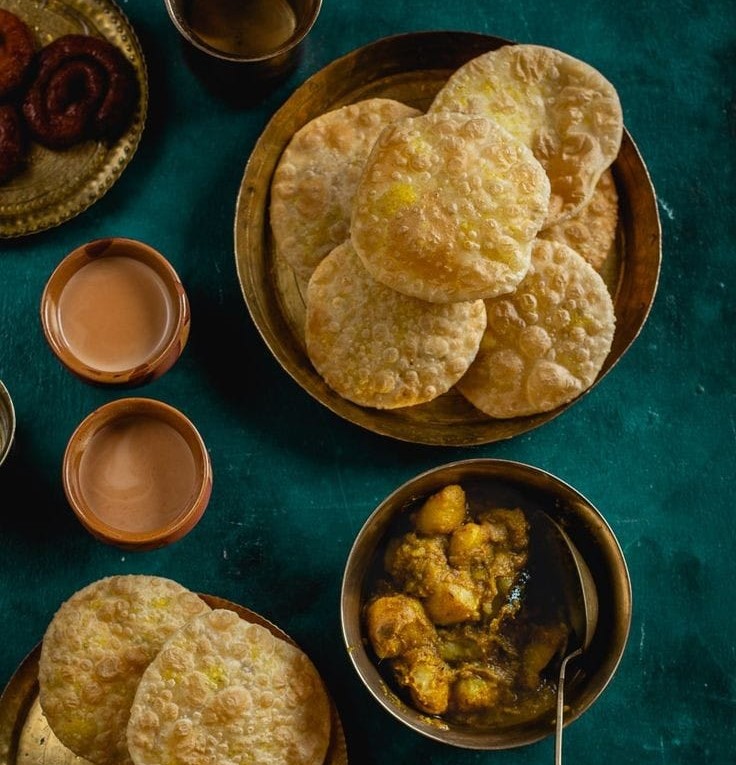
Radhaballavi Recipe || Bengali Daal Puri
Bengali cuisine is a treasure trove of delectable dishes that tantalize the taste buds with a symphony of flavors. Among the myriad of culinary delights that the Bengali kitchen offers, Radhaballavi stands out as a beloved classic. This deep-fried, stuffed bread dish is a testament to the rich culinary heritage of West Bengal, India, and is enjoyed by people of all ages and backgrounds.
Radhaballavi’s history can be traced back to the heart of Bengali culture, Kolkata, and its surrounding regions. The dish is believed to have originated during the Mughal era when North Indian influences seeped into Bengali cuisine. Over time, it became an integral part of the culinary landscape and evolved to reflect the unique flavors and preferences of the Bengali people.
Radhaballavi is a popular Bengali delicacy that consists of deep-fried, stuffed flatbreads. These delicious lentil-stuffed bread are often served with cholar dal (Bengali style chana dal) and a side of potato curry. Here’s a recipe to make Radhaballavi:
Ingredients:
For the Dough:
- 2 cups all-purpose flour (maida)
- 2 tablespoons semolina (sooji)
- 2 tablespoons ghee or oil
- A pinch of salt
- Water, as needed
For the Stuffing:
- 1 cup split skinless black gram (urad dal), soaked for 4-5 hours
- 2-3 green chilies, finely chopped
- 1-inch piece of ginger, grated
- 1/2 teaspoon asafoetida (hing)
- 1 teaspoon cumin seeds (jeera)
- 1 teaspoon fennel seeds (saunf)
- 1/2 teaspoon turmeric powder (haldi)
- 1/2 teaspoon red chili powder (adjust to taste)
- Salt to taste
- Oil for deep frying
Directions:
For the Dough:
Step 1
In a mixing bowl, combine the all-purpose flour, semolina, ghee or oil, and a pinch of salt.
Step 2
Gradually add water while kneading to make a smooth and firm dough. The dough should not be too soft or too hard.
Cover the dough with a damp cloth and let it rest for at least 30 minutes.
For the Stuffing:
Step 1
Drain the soaked urad dal and grind it to a coarse paste without adding water.
Step 2
Heat a tablespoon of oil in a pan and add asafoetida, cumin seeds, and fennel seeds. Sauté for a minute until they release their aroma.
Step 3
Add the chopped green chilies and grated ginger. Sauté for another minute.Add the coarsely ground urad dal, turmeric powder, red chili powder, and salt to the pan. Cook the mixture on low to medium heat, stirring continuously until it dries up and becomes a thick, non-sticky paste. This will take about 10-12 minutes. Remove it from the heat and let it cool.
Assembling and Frying Radhaballavi:
Step 1
Divide the dough into small, equal-sized balls.
Step 2
Take one dough ball and flatten it into a small disc, about 3 inches in diameter, using your fingers or a rolling pin.
Step 3
Place a spoonful of the cooled urad dal stuffing in the center of the disc. Gather the edges of the dough disc and seal the stuffing inside, forming a ball.
Step 4
Gently flatten the stuffed ball with your fingers to make a small, stuffed disc.
Repeat this process for the remaining dough balls.
Step 5
Heat oil in a deep frying pan or kadai over medium heat. Carefully slide the stuffed discs into the hot oil, one at a time.
Fry them until they turn golden brown and crisp on both sides. Make sure to flip them occasionally for even frying.
Remove the fried Radhaballavi from the oil using a slotted spoon and place them on a paper towel to remove excess oil.
Serve Radhaballavi hot with cholar dal and potato curry for a delicious Bengali meal. Enjoy!
Tips for Radhaballavi
Making perfect Radhaballavi requires attention to detail and a few tips can help you achieve that delicious, crispy, and flavorful result:
Consistency of Dough: Ensure that the dough for Radhaballavi is neither too soft nor too hard. It should be firm yet pliable. Use just enough water to bring the dough together.
Resting Time: Allow the dough to rest for at least 30 minutes. This resting period relaxes the gluten in the dough, making it easier to work with and resulting in softer bread.
Stuffing: Be careful not to overstuff the Radhaballavi, as it can burst while frying. The stuffing should be well-cooked and dry to prevent leakage.
Sealing Properly: Seal the stuffed dough balls properly to ensure that the filling doesn’t come out during frying. Press the edges firmly and evenly to create a secure seal.
Rolling Technique: While rolling the stuffed dough balls, be gentle. Apply even pressure with your fingers to create a smooth and evenly thick Radhaballavi.
Oil Temperature: Maintain the oil at a consistent medium heat. If the oil is too hot, the Radhaballavi may brown too quickly on the outside while the inside remains undercooked.
Frying Time: Fry the Radhaballavi until they are uniformly golden brown on both sides. This ensures that they are crispy and cooked all the way through.
Draining Excess Oil: After frying, place the Radhaballavi on a paper towel-lined plate to absorb any excess oil.
Serve Hot: Radhaballavi is best enjoyed hot and fresh. Serve it immediately after frying for the best taste and texture.
Accompaniments: Radhaballavi is traditionally served with cholar dal (Bengali-style chana dal) and aloo dum (spiced potato curry). The combination of these dishes adds a perfect balance of flavors to your meal.
Variations: Feel free to experiment with the stuffing. You can add spices, herbs, or even grated vegetables to the urad dal mixture to create different flavors and textures.
Remember that making perfect Radhaballavi might take some practice, but the effort is well worth it for this delicious Bengali treat.